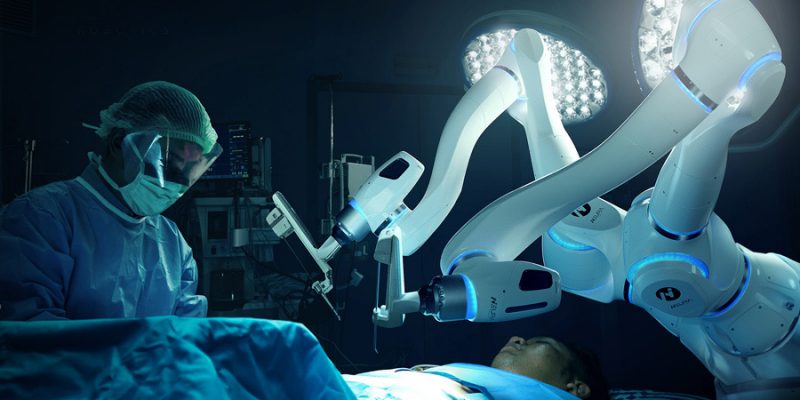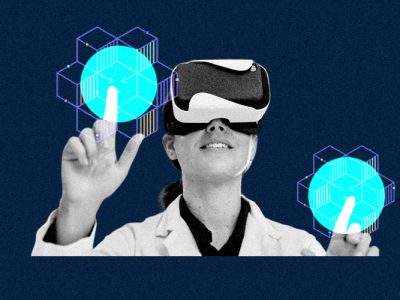
Smart co-bots in the healthcare industry have increased operational effectiveness thanks to AI.
In the medical industry, robots are revolutionizing how procedures are carried out, speeding supply delivery and sterilization, and allowing professionals to concentrate on interacting and caring for patients. Hospital processes have been significantly improved because of artificial intelligence. AI has improved operational efficiency by assisting in the efficient routing of capital resources through smart allocation, with a focus on solving particular holes in the system, in an already strained healthcare ecosystem with limited resources. Even if a lot may have transpired, it has only included automating the hospital’s administrative operations and gathering and analyzing its electronic medical information. Modern technology has now entered the operating room and the human body thanks to AI-powered robots. The collaborative robots can deliver real-time scans and photographs of the interior of the human body in addition to doing surgery on patients, which might be very helpful in operations.
The processes in hospitals have significantly changed thanks to artificial intelligence. AI has improved operational efficiency by efficiently allocating capital resources through smart allocation, with a focus on fixing particular holes in the system, in a healthcare ecosystem that is already stretched thin and has limited resources. When operating on a patient, tremendous accuracy is needed, thus there can be no room for human mistakes. The goal of robotic surgeons using AI is to achieve this. A handful of the surgical robots that are now on the market do vision analytics when they are inserted into the human body. The collaborative robots can deliver real-time scans and photographs of the human body in addition to doing surgery on patients.
Robotic surgeons are now combined with AI, according to Srinivas Iyengar, Vice President-Healthcare, Happiest Minds Technologies. If you were to examine a patient with a brain tumor’s CT images. Only 2-D photos will be shown. The third depth dimension is not disclosed. The doctor may continually scan the brain during surgery with these robots, and with the aid of AI, they can determine the tumor’s third dimension, which further reveals how far it extends or if the robot has reached the proper depth to scrape the tumor. He continued by saying that one might use the data currently present for the algorithm in situations like tumor detection. “The model may be trained using a large amount of labeled data on the identification of cancers. Additionally, the model gets smarter the more photographs we add. The doctor may use this information to help him decide. We like to refer to enhanced intelligence because of this. Since the goal is to increase clarity rather than do away with the doctor’s role, he continued.”Robotic-assisted surgery combines the expertise of surgeons with a technical background with state-of-the-art computer technology. At Intuitive, we have concentrated our digital technologies on curating high-quality clinical data—data that is pertinent, secure, and capable of revealing useful insights—from clinical operations. Artificial intelligence and machine learning methods, which are essential to our product design and strategy, complement this plan, which is based on the more than 10 million da Vinci operations conducted worldwide, according to Mandeep Singh Kumar, Vice President & Country GM, Intuitive India.
Even though the application of analytics and AI in co-bots is currently limited, the range is not. Science fiction could soon become a reality given the speed at which research is progressing in doctorless surgery and remote operation. The robot might occasionally do the entire procedure under the supervision of a doctor, but for the time being, a doctorless operation is still only a theoretical possibility. There have also been instances where a robot imitates the movement of the real human body in location B while a doctor operates on the digital twin of the patient in location A. But at this time, research is still being done on these use cases.
Excellent Patient Care
Intelligent therapies, frequent and individualized monitoring for patients with chronic illnesses, minimally invasive operations, and social interaction for elderly patients are all made possible by medical robots. Additionally, when robots reduce workloads, nurses and other healthcare providers may contact patients more personally and show more compassion, both of which can improve patients’ long-term wellbeing.
Clinical Process Improvements
The use of co-bots streamlines regular activities eases the physical burden on human employees and promotes more reliable operations. By keeping track of inventories and timely ordering, these robots may assist ensure that supplies, equipment, and medications are available where they are required, addressing personnel shortages and issues. disinfection and cleaning AMRs make it possible for hospital rooms to be promptly cleaned and prepared for new patients, freeing up staff members to concentrate on patient-centered, value-driven work.
A secure workplace
In hospitals where there is a possibility of disease exposure, co-bots are used to convey supplies and linens to help keep healthcare staff safe. Numerous healthcare facilities now use cleaning and disinfection robots to decrease the spread of pathogens and hospital-acquired illnesses (HAIs). Co-bots, such as social robots, assist with heavy lifting by moving beds or patients, easing the physical burden on healthcare professionals.



















